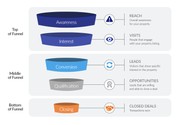
Marketing Best Practices
How to Create a Real Estate Funnel
Imagine if you could make one simple improvement to your marketing and sales process, and see an instant boost in the number of closed deals.
That’s how a funnel can help you.
If you’re serious about marketing your properties, improving lead generation or closing more deals, then keep reading…
What is a real estate sales funnel?
A marketing or sales funnel is an effective way for you to break down the entire sales journey of closing a client into specific, measurable stages. This can be applied to almost any commercial real estate process, both for leasing or sales.
Why do I need a funnel?
Funnels are important because they help you understand what part of your marketing and sales operations are working effectively. More importantly, it also helps identify problem areas that need improvement (leaks or clogs).
It shows all the stages needed to close a deal and can help bridge the gap to better align your marketing and sales processes towards a common objective to help your company grow.
How do I create a sales funnel?
Creating a real estate funnel is simple:
Step #1 – Stages
Break down your client’s journey into key stages of your marketing and sales activity
Step #2 – KPIs
Set relevant KPIs (key performance indicators) to measure activity of each stage
Step #3 – Track and report
Track performance of each stage to understand where you need to improve
For most commercial real estate companies, whether for investment sales or for a lease-up effort, your marketing and sales funnel stages can consist of the following:
- Awareness (reach)
- Interest (visits)
- Conversion (leads)
- Qualification (opportunities)
- Closing (closed deals)

1. Awareness
The top of any funnel is completely focused on attracting potential clients.
How well do your commercial real estate marketing strategies create awareness for your property?
The ability to create awareness can come in many different forms, both online and offline, and there are plenty of creative property marketing tactics to consider. In general, you want to try to measure the extent of your exposure and reach generated through different marketing channels.
Prospects in this stage are not yet ready to engage so this is a good opportunity demonstrate the value proposition of your property and pique their interest to move them into the next state.
Some metrics you may want to consider:
- Email opens
- Ad impressions
- Social media views
- News clippings
2. Interest
In the interest phase, a prospect has now become more engaged with your property and is willing to consider a potential deal.
This is where the quality and depth of your listing content is very important and has an immediate impact on demand generation to move them into the next stage.
You should be thinking:
What can I do to engage prospects as soon as they land on my property listing?
Take time to create a listing presentation that demands attention and generates an immediate “wow” factor to capture interest.
Some metrics you may want to consider:
- Visits to website
- Time spent on site
- Bounce rate
- Specific actions (downloads, newsletter sign ups, etc.)
3. Conversion
What is the lifeblood of any real estate marketing or sales process?
One simple word: leads.
The effectiveness of your marketing comes down to how well you can convert visitors from the previous stage (consideration) into warm leads that have shown interest in your property and inquire for more information.
This where a good CRE marketing team can rely shine and help their brokers.
Marketing is not always about creating shiny collateral, it’s about putting into place repeatable processes that move people through the funnel and effectively convert them into a potential prospect for a broker.
The ability to convert leads is based on two things:
1. Effectiveness of your property listing to drive action
2. Volume of people in previous stages
Some metrics you may want to consider:
- Total leads (inquiries)
- Lead conversion rate % (total leads / total visits)
4. Qualification
Not all leads are created equal.
Although the total volume of leads is important, the quality of your leads is even more critical.
What you don’t want is a real estate funnel that is producing the wrong kind of leads (buyers, investors or tenants that are not a good fit for you). This can be a huge loss of your time and effort.
This is why lead qualification is an important stage of any funnel, and where you can separate potential opportunities (qualified leads) that can convert into deals from the tire kickers that are wasting your time.
Property tours are a relevant opportunity to gauge the level of interest and may be another middle of the funnel metric to consider as part of the qualification step.
Remember: success in closing any real estate transaction depends on this step.
Some metrics you may want to consider:
- Total opportunities
- Opportunity conversion rate % (total opportunities / total leads)
5. Closing
The final step of any real estate sales funnel is the end game: closing deals.
Whether it’s a property that is sold or space that is leased, the ultimate measure of success for any funnel can be reduced to the deals you win.
However, to have a more comprehensive view of executed deals, you can also break down the “closing” stage into more granular steps such as:
– Proposals sent
– LOIs sent
– Offers submitted
– etc.
This will allow you to further track and improve performance at each stage and better gauge your sales forecasting.
You may also considering tracking two additional dimensions (Deal Size and Total SF ) to give you more meaningful information about the total opportunity at the bottom of the funnel.
Some metrics you may want to consider:
- Total closed deals
- Closing conversion rate % (total closed deals / total opportunities)
- Conversion rate % of additional stages (LOIs, proposals, offers, etc.)
Conclusion
Once you have identified and organized your real estate marketing and sales process into a funnel, it’s important to measure and optimize each stage of the funnel on a continuous basis.
The benefit of creating a real estate funnel is that you’ll have a visual representation that allows you to quickly assess whether you are slipping in any area. This gives your marketing and brokerage teams the ability to align and fix “leaks” or “clogs” to help drive growth of your company sales in a very systematic way.
Related Blog Posts
CRE Technology
5 Reasons Why Salesforce Needs a CRE Marketing Platform
Salesforce isn’t only the most widely used CRM, it’s also the leading choice in the...
Company updates
Streamline Your Outreach with Tag-Based Email Campaigns
We are thrilled to announce the launch of our new Tag-Based Email Campaign feature, designed...
Company updates
SharpLaunch Announces New Integration with LandSearch
We’re excited to announce a groundbreaking integration with LandSearch, a prominent online...



